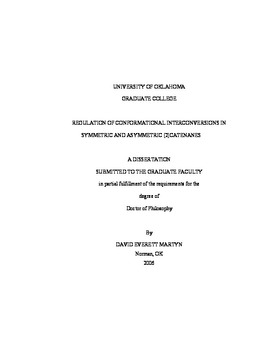| dc.contributor.advisor | Halterman, Ronald L., | en_US |
| dc.contributor.author | Martyn, David Everett. | en_US |
| dc.date.accessioned | 2013-08-16T12:20:20Z | |
| dc.date.available | 2013-08-16T12:20:20Z | |
| dc.date.issued | 2006 | en_US |
| dc.identifier.uri | https://hdl.handle.net/11244/1075 | |
| dc.description.abstract | Using non-biasing tethers, consisting of phenyl rings designed to be blocking or non-blocking in nature, we were able to control the pathway for interconversion. Through the appropriate incorporation of blocking groups on one or both of two phenyl tethers it was possible to block one or both of the two pathways for circumrotation in our bistable catenanes. The free energies of activation required for circumrotation over the open, non-blocking pathways were calculated at 11 to 13 kcal/mol. The isomer ratios for these catenanes were 1 to 1 indicating the two conformations were isoenergetic. Using these symmetric catenanes, we demonstrated the ability to dictate the pathway over which circumrotation occurred in a non-covalently bound system. | en_US |
| dc.description.abstract | In our studies, we investigated control of molecular motion as it could pertain to the emerging area of molecular machines and ratchets. We based our studies on the movement in mechanically interlocked molecular rings known as catenanes. These [2]catenanes possessed a dibenzo-34-crown-10 ether interlocked with a ring containing two 4,4'-dipyridiniums connected by aryl tethers. These novel catenanes contain bistable binding sites separated and connected by biasing or non-biasing tethers. | en_US |
| dc.description.abstract | Using asymmetric, biasing tethers we sought to drive circumrotation preferentially in one direction using a gate that would discriminate between the two conformations. Allosteric interaction between the gate and catenated crown ether would either allow or disallow translocation over the gate based on the direction of circumrotation. The free energies of activation for circumrotation were calculated at 11 to 19 kcal/mol. While two gating catenane systems did appear to display the anticipated characteristics, the results were not convincing and could be attributed to other phenomenon. (Abstract shortened by UMI.) | en_US |
| dc.description.abstract | Using asymmetric, non-biasing tethers we determined the extent to which the isomer ratios were dependant on the symmetry of the catenanes, and measured the thermodynamic preference displayed between the two conformers. Circumrotation in these catenanes required between 11 and 15 kcal/mol of energy. We found the conformer stabilities were symmetry dependent displaying isomer ratios of between 1.5:1 and 3.5:1. This indicated that one conformation was more stable. | en_US |
| dc.format.extent | ix, 304 leaves : | en_US |
| dc.subject | Asymmetry (Chemistry) | en_US |
| dc.subject | Chemistry, Organic. | en_US |
| dc.subject | Intermolecular forces. | en_US |
| dc.subject | Catenanes. | en_US |
| dc.title | Regulation of conformational interconversions in symmetric and asymmetric [2]catenanes. | en_US |
| dc.type | Thesis | en_US |
| dc.thesis.degree | Ph.D. | en_US |
| dc.thesis.degreeDiscipline | Department of Chemistry and Biochemistry | en_US |
| dc.note | Source: Dissertation Abstracts International, Volume: 67-06, Section: B, page: 3141. | en_US |
| dc.note | Adviser: Ronald L. Halterman. | en_US |
| ou.identifier | (UMI)AAI3222154 | en_US |
| ou.group | College of Arts and Sciences::Department of Chemistry and Biochemistry | |
